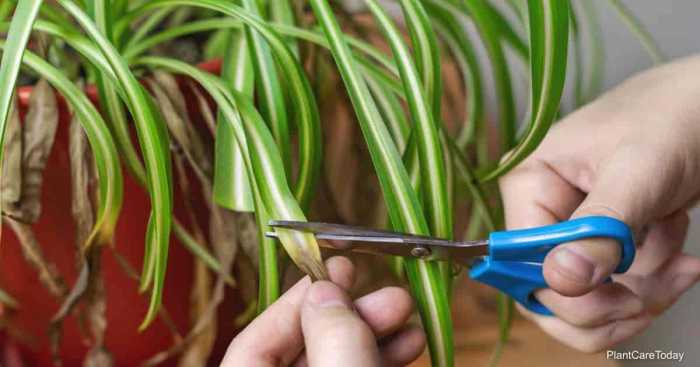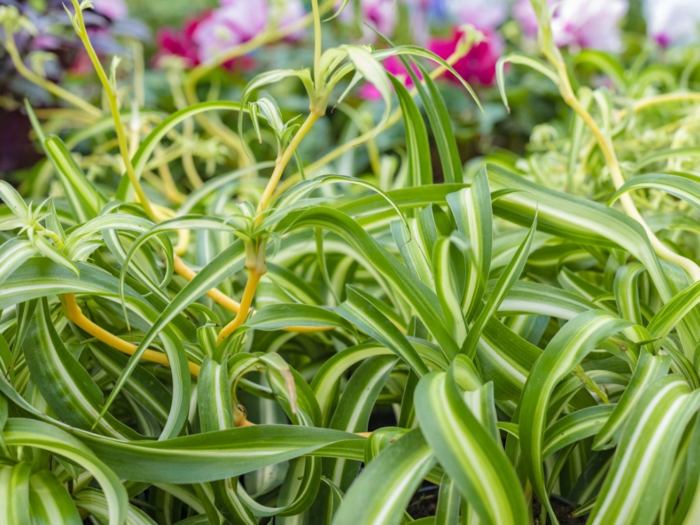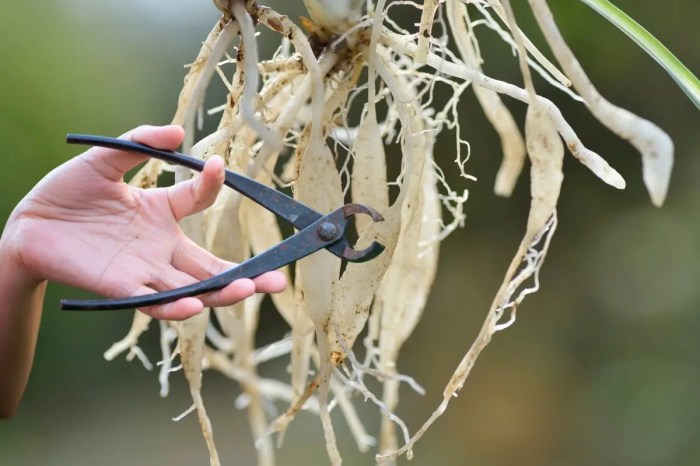How to trim spider plants – Master the art of spider plant trimming with our comprehensive guide. Whether you’re a seasoned gardener or a budding enthusiast, this article provides expert insights and step-by-step instructions to keep your spider plants thriving and aesthetically pleasing.
Regular trimming not only enhances the appearance of these popular houseplants but also promotes their overall health and vitality. Our guide covers everything from trimming techniques and timing to repurposing trimmings and troubleshooting common issues.
Trimming Techniques

Regular trimming is essential for maintaining the health and appearance of spider plants. It encourages new growth, prevents leggy and overgrown plants, and enhances the plant’s overall aesthetic appeal.
To trim spider plants, follow these steps:
- Inspect the plant:Identify any dead, yellowing, or brown leaves. Remove these leaves by gently pulling them off at the base.
- Prune runners:Spider plants produce long runners that can become tangled and unsightly. Trim these runners back to the main plant, leaving a few nodes to encourage new growth.
- Shape the plant:Trim the tips of the leaves to create a more compact and uniform shape. This also encourages the plant to produce new shoots from the trimmed areas.
For larger spider plants, you may need to use pruning shears to trim the thicker stems. Always use sharp, clean tools to avoid damaging the plant.
The specific trimming method may vary depending on the shape and size of your spider plant. For smaller plants, simple pruning with scissors may suffice. For larger plants, more extensive pruning with pruning shears may be necessary.
To trim spider plants, begin by removing any dead or damaged leaves. Use sharp scissors to cut back any long or overgrown leaves to maintain a neat and healthy appearance. For more detailed instructions on pruning and maintaining other plants, consider reading our guide on how to cut the rose plant . By following these simple steps, you can keep your spider plants thriving and looking their best.
Frequency and Timing

Maintaining the health and aesthetic appeal of spider plants requires regular trimming. Understanding the appropriate frequency and timing for trimming is crucial for optimal plant growth and longevity.
Spider plants are well-known for their unique appearance and easy maintenance. When it comes to trimming spider plants, it’s essential to understand the general principles of plant trimming. For more detailed instructions on trimming plants in general, you can refer to our comprehensive guide how to trim a plant . Returning to the topic of spider plants, regular trimming helps promote healthy growth and prevents the plant from becoming overgrown or leggy.
As a general guideline, it is recommended to trim spider plants every 2-3 months. This frequency allows for the removal of dead or yellowing leaves, spent blooms, and excess growth, promoting a healthy and tidy appearance.
Optimal Time of Year
The optimal time of year for trimming spider plants is during the growing season, typically spring and summer. During these seasons, plants are actively growing and have a higher tolerance for trimming, allowing them to recover quickly.
Signs of Trimming Need
- Dead or yellowing leaves:Remove any leaves that have turned brown, yellow, or are wilted.
- Spent blooms:Cut back any spent flower stalks to encourage new growth and prevent seed production.
- Excess growth:If the plant has become overgrown or leggy, trim back long or trailing stems to maintain a compact and healthy shape.
- Pest or disease:Trim away any leaves or stems that show signs of pests or diseases to prevent their spread.
Tools and Equipment

Trimming spider plants requires specific tools to ensure a clean and precise cut. The recommended tools are:
- Sharp, clean scissors
- Sterile pruning shears
- A sharp knife (optional)
It is crucial to sterilize the tools before use to prevent the spread of diseases. Wipe the blades with rubbing alcohol or a 10% bleach solution. Rinse thoroughly with water and dry before using.When using sharp objects, always handle them with care.
Wear gloves to protect your hands from cuts and puncture wounds. Cut away from your body and keep the blades pointed downward to avoid accidental injuries.
Repurposing Trimmings: How To Trim Spider Plants
The versatility of spider plants extends beyond their aesthetic appeal. Trimming provides an opportunity to repurpose the discarded leaves, offering sustainable and practical uses.
Propagation, How to trim spider plants
Trimmed spider plant leaves can be easily propagated to create new plants. Simply cut a leaf with a sharp knife or scissors, ensuring that it includes a node (small bump) where roots will form. Place the cutting in a glass of water or moist soil, and within a few weeks, you will observe root development.
Once the roots are well-established, you can transplant the new plant into a pot.
Compost and Mulch
Spider plant trimmings can be added to your compost pile or used as mulch in your garden. The leaves are rich in nutrients and organic matter, which can improve soil health and fertility. When used as mulch, spider plant leaves help retain moisture, suppress weeds, and regulate soil temperature.
Troubleshooting Common Issues

Trimming spider plants is generally straightforward, but certain issues can arise during the process. Identifying and addressing these problems promptly ensures the plant’s health and prevents future trimming difficulties.
Overgrowth
Excessive growth can lead to overcrowding and hinder the plant’s ability to absorb nutrients and sunlight. Regularly trim overgrown spider plants to maintain their size and shape. Remove excess runners and leaves to promote airflow and prevent overcrowding.
Yellowing Leaves
Yellowing leaves can indicate nutrient deficiencies, overwatering, or pest infestations. Address nutrient deficiencies by fertilizing the plant regularly. Reduce watering frequency to prevent overwatering. Inspect the plant for pests and treat accordingly.
Trimming spider plants involves removing dead or damaged leaves and stolons. While spider plants require less pruning compared to other plants, it’s essential to keep them healthy. For a more in-depth guide on plant trimming, consider reading how to trim blueberry plants . Trimming spider plants can also help promote new growth and improve their overall appearance.
Pest Infestations
Spider plants are susceptible to common pests like aphids, mealybugs, and spider mites. Regularly inspect the plant for signs of infestation. Treat pests promptly using insecticidal soap or neem oil. Prevent future infestations by maintaining proper hygiene and avoiding overwatering.
Wrap-Up
By following the techniques Artikeld in this guide, you’ll be able to maintain healthy and visually appealing spider plants that will brighten up any living space. Remember, trimming is an essential aspect of spider plant care, and with the right knowledge and techniques, you can keep your plants flourishing for years to come.
General Inquiries
How often should I trim my spider plant?
Trim your spider plant every 6-8 weeks to remove dead or yellowing leaves and promote new growth.
Can I propagate spider plants from trimmings?
Yes, spider plants can be easily propagated by placing cuttings in water or soil.
What can I do with spider plant trimmings?
Spider plant trimmings can be used for propagation, composting, or mulching.